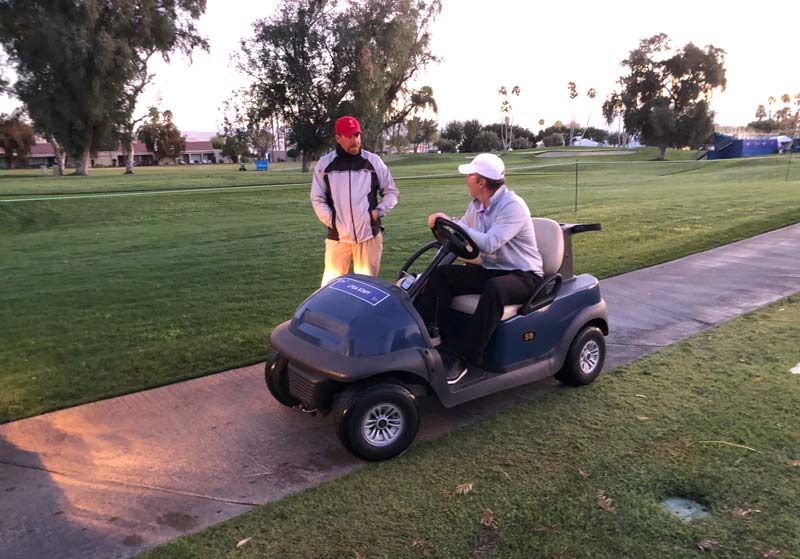
Jared Taylor, superintendent of Mission Hills Country Club’s Dinah Shore Tournament Course — where this week’s LPGA ANA Inspiration is being contested — takes a Stimpmeter reading on the 13th green. Photos by Scott Hollister
For those wondering about the glamorous life of a host superintendent for a professional golf event, this is how Jared Taylor, the host of this week’s ANA Inspiration on the LPGA Tour, started his Wednesday morning: kneeling in wet rough, cup-cutter in hand, repairing small scalp marks by the light of the headlights on his utility vehicle.
“Just knocking things off the punch list,” the seven-year GCSAA member said when greeting a pair of guests who found him in that predicament just off the ninth green on the Dinah Shore Tournament Course at Mission Hills Country Club in Rancho Mirage, Calif. “It’s not exciting, but someone has to get it done.”
And for the ANA Inspiration, that’s extra important, because there are no volunteers assisting with course maintenance during tournament week — just the full-time staff members available to Taylor, the head superintendent on the Tournament Course, and David Hay, CGCS, the director of agronomy at Mission Hills.
Now, neither Taylor nor Hay is crying poor this week. They know they have it better than most. Mission Hills is a 54-hole facility, after all, with 60 full-time staff spread over its three golf courses (along with tennis and croquet facilities), so they’re able to pull together a crew of between 35 to 40 each morning to assist with tournament prep.

Jared Taylor chats with LPGA Tour agronomist John Miller ahead of the ANA Inspiration, the first major of the golf season. The Dinah Shore Tournament Course has been the site of the annual event since 1972.
“I know that we’re pretty lucky to have the flexibility that we do here, and that we can do all this to the level that we do with just our own staff,” Taylor says. “There are definitely times when it would be nice to have volunteers and the extra manpower, but for the most part, we like the situation we have.”
Even when it means more work for folks like Taylor, who definitely fits the bill of a working superintendent. Wednesday morning was a great example: In addition to fixing those small scalped areas on the collar in front of No. 9 green and then on the back of No. 2 green, Taylor hand-watered a few hot spots on the practice putting green, adjusted tee markers for the day’s pro-am on no less than five holes, and helped repair an area on No. 9 fairway that had been dinged when a mower picked up a stick and dragged it for about 15 feet before being detected.
Taylor also wore his supervisory hat, providing instruction to an operator who was cleaning up debris from high winds that had blown through the valley overnight. He consulted with Hay on how best to wrap up greens rolling before the pro-am swung into full gear, took Stimpmeter and moisture readings on several greens, and generally kept crews moving and motivated throughout the morning.
“It always feels pretty chaotic at this time of tournament week. Monday is different from Tuesday, which is different from Wednesday,” Taylor says. “But once the tournament starts, things seem to settle in, and we really nail our routines. Weather looks good, course is where we want it, and we’re ready to go.”
Scott Hollister is GCM’s editor-in-chief.